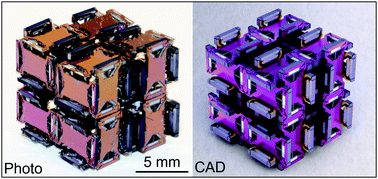Design and fabrication of a three-dimensional meso-sized robotic metamaterial with actively controlled properties†
Abstract
Metamaterials can achieve naturally unobtainable properties according to how their microarchitectures are engineered. By incorporating robot-inspired actuators, sensors, and microprocessors within their microarchitectures, still more extreme properties and diverse combinations of properties can be achieved; and their properties can be actively tuned in real time according to uploaded control instructions. Despite the enormous potential of such robotic metamaterials, no three-dimensional designs have been demonstrated because such designs are difficult to make using existing fabrication approaches. Making them with constituent cells small enough to be considered a material instead of a collection of macro-sized robots is even more difficult. Here we demonstrate the first fabricated three-dimensional robotic metamaterial that achieves actively controlled properties. It's cells are meso-sized (5 mm), which make them the smallest robots to date among those intended to work together within a lattice for achieving any objective. We optimize the design's geometry and demonstrate its ability to tune its stiffness as desired using closed-loop control.



 Please wait while we load your content...
Please wait while we load your content...
